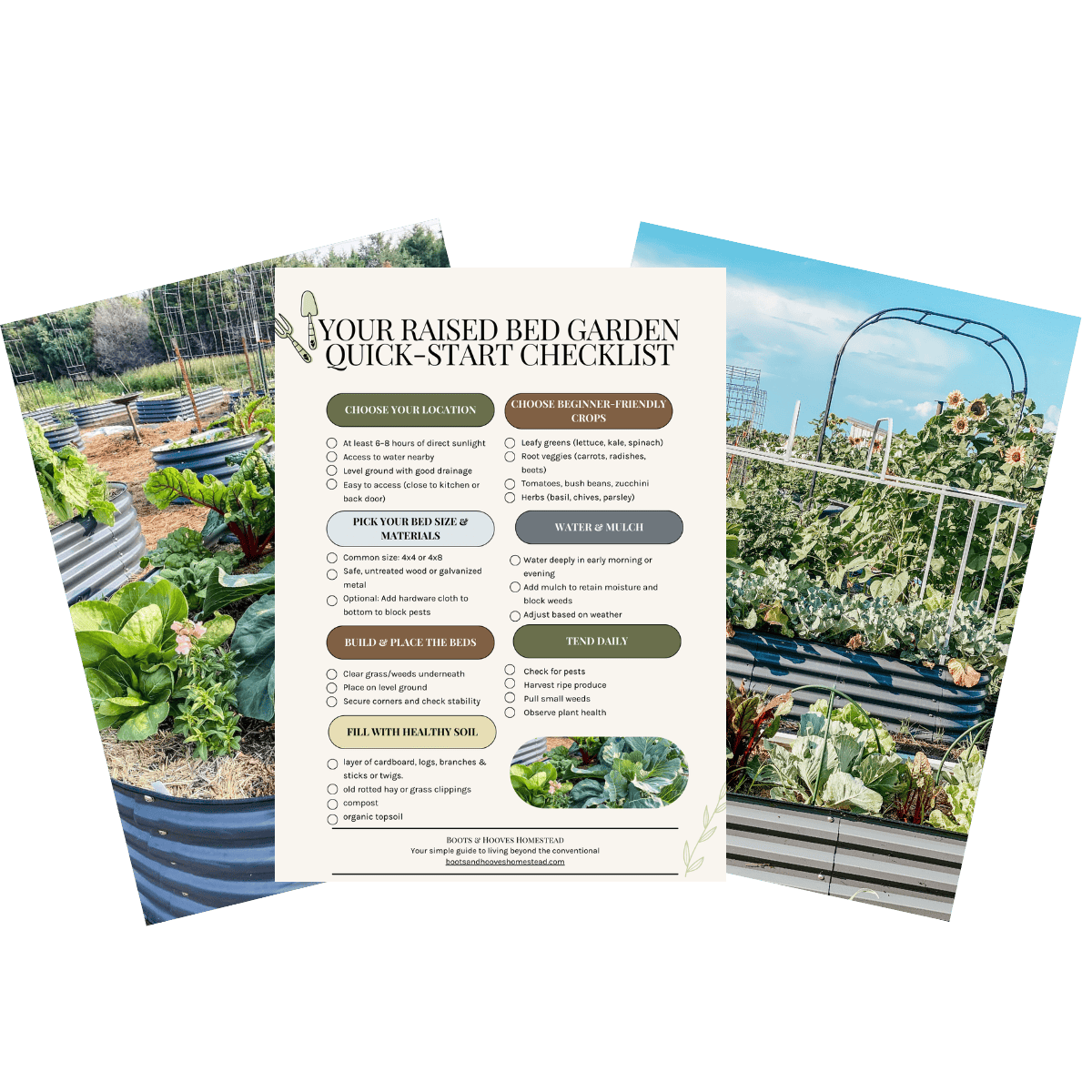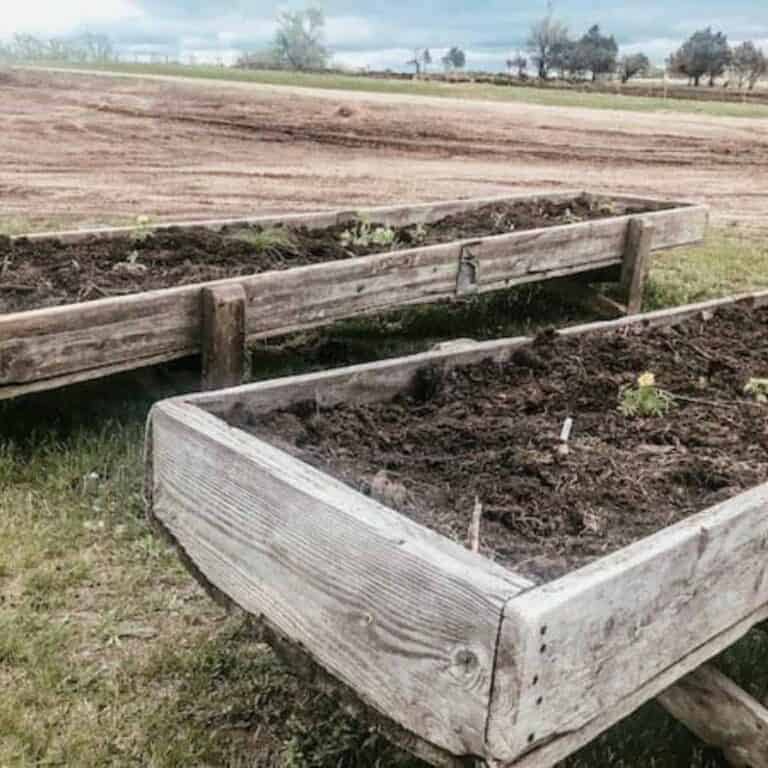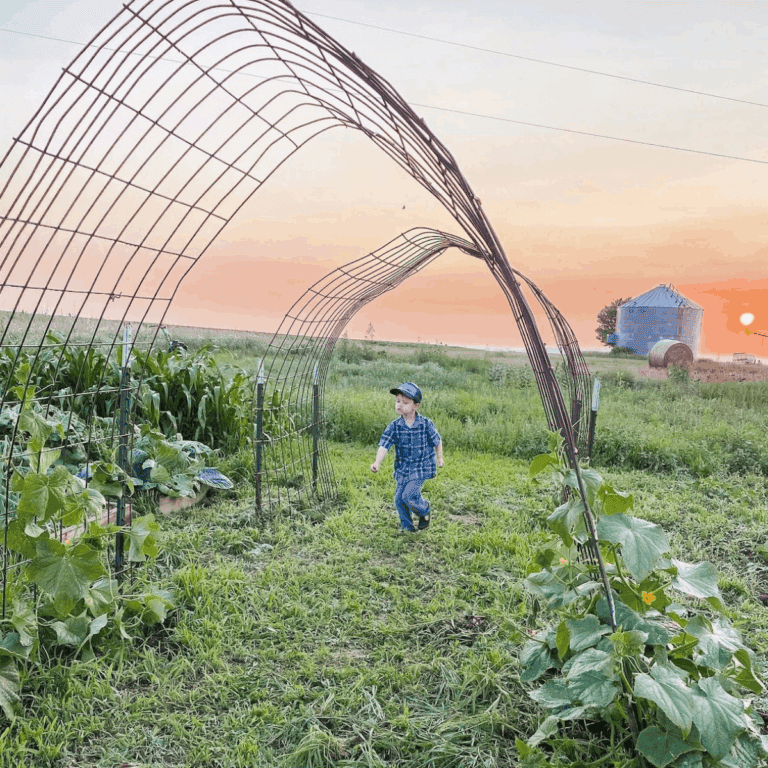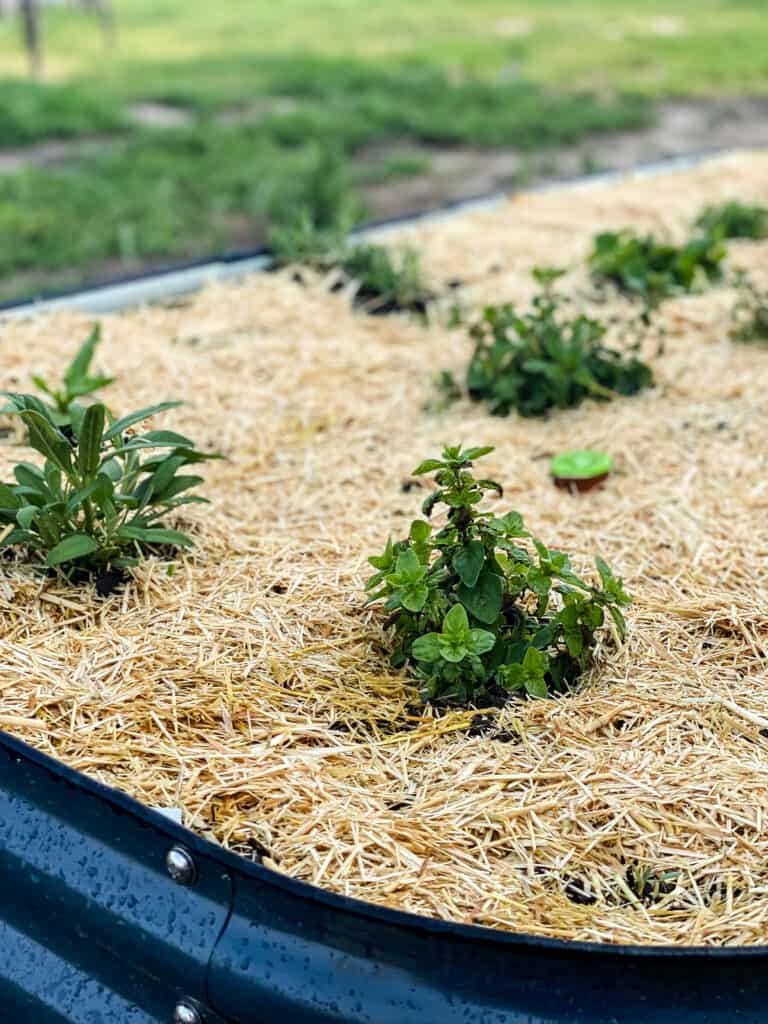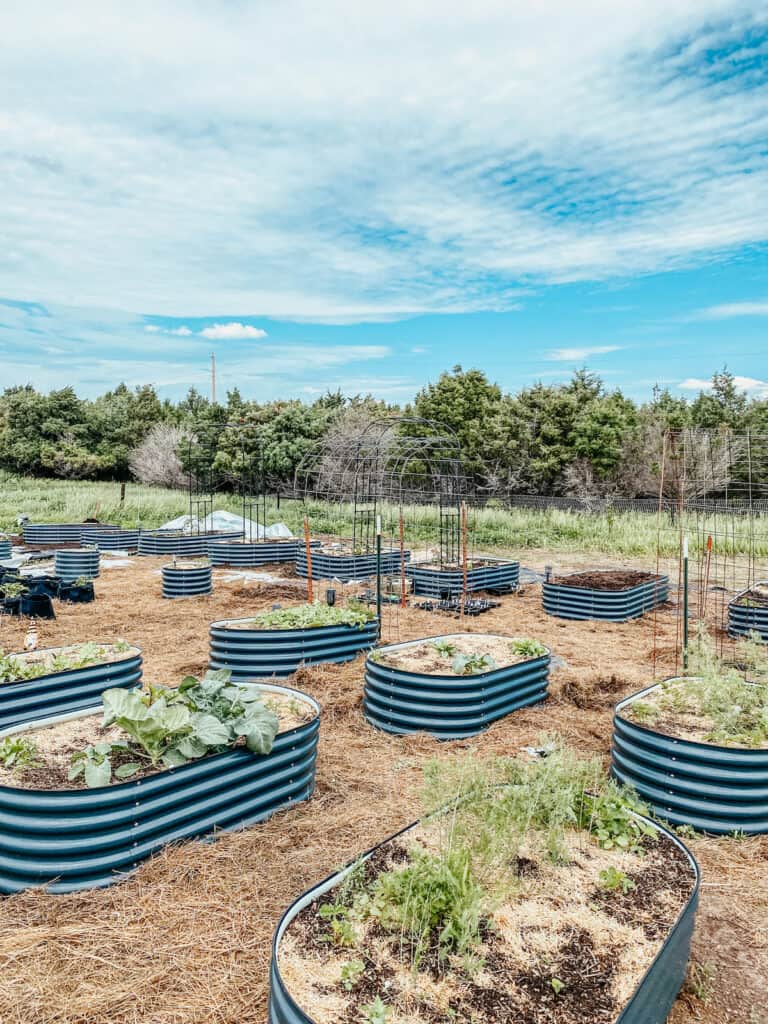Beginner’s Guide to Starting a Raised Bed Garden
Want to grow fresh veggies without the overwhelm? This beginner’s guide to raised bed gardening shares easy steps to help busy moms start growing food simply and successfully—even with limited time and space.
Grow More Food with Less Work — Even If You’re Just Getting Started
So, you’re dreaming of fresh garden veggies, but maybe you’re not quite sure where to begin? You’re in the right place, friend. Raised bed gardening is one of the easiest ways to get started growing your own food—especially if you’re short on time, space, or experience.
Here at Boots & Hooves Homestead, I’m all about making this kind of simple, wholesome living doable for busy moms. Whether you want to grow your first tomato plant or feed your whole family from the backyard, this beginner’s guide will walk you through every step of starting a raised bed garden—from the ground up.
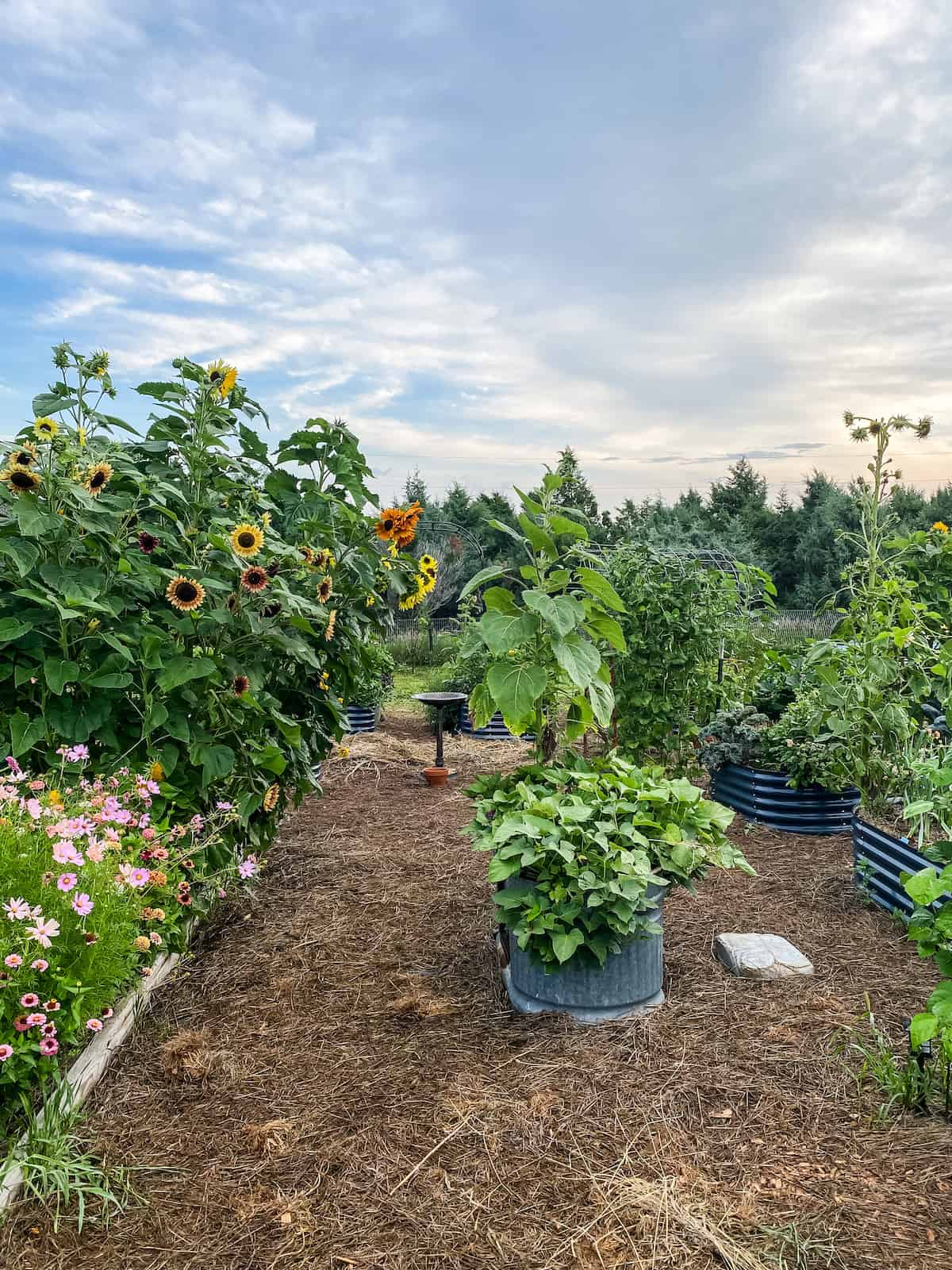
🌿 Why Choose Raised Beds?
For many years, we grew a small garden the traditional way — in small plots in the backyard. After we moved to our new home, I wanted something that was easier for me to maintain in various seasons of being a busy mom. Plus easier on my aging body, too!
Raised beds have been the solution I needed. We’ve been growing the majority of our veggie garden using this method for about 5+ years now.
Raised beds are ideal for new gardeners because:
- They’re easy to maintain – fewer weeds, better drainage, and less bending over!
- You can control your soil quality – which means healthier plants and fewer pests.
- They look tidy and organized – perfect for backyards, homesteads, or even front yards.
Plus, they make gardening approachable, manageable, and rewarding—even if you only have 15 minutes a day to spare.
So, let’s chat about how to get started on gardening in raised beds.
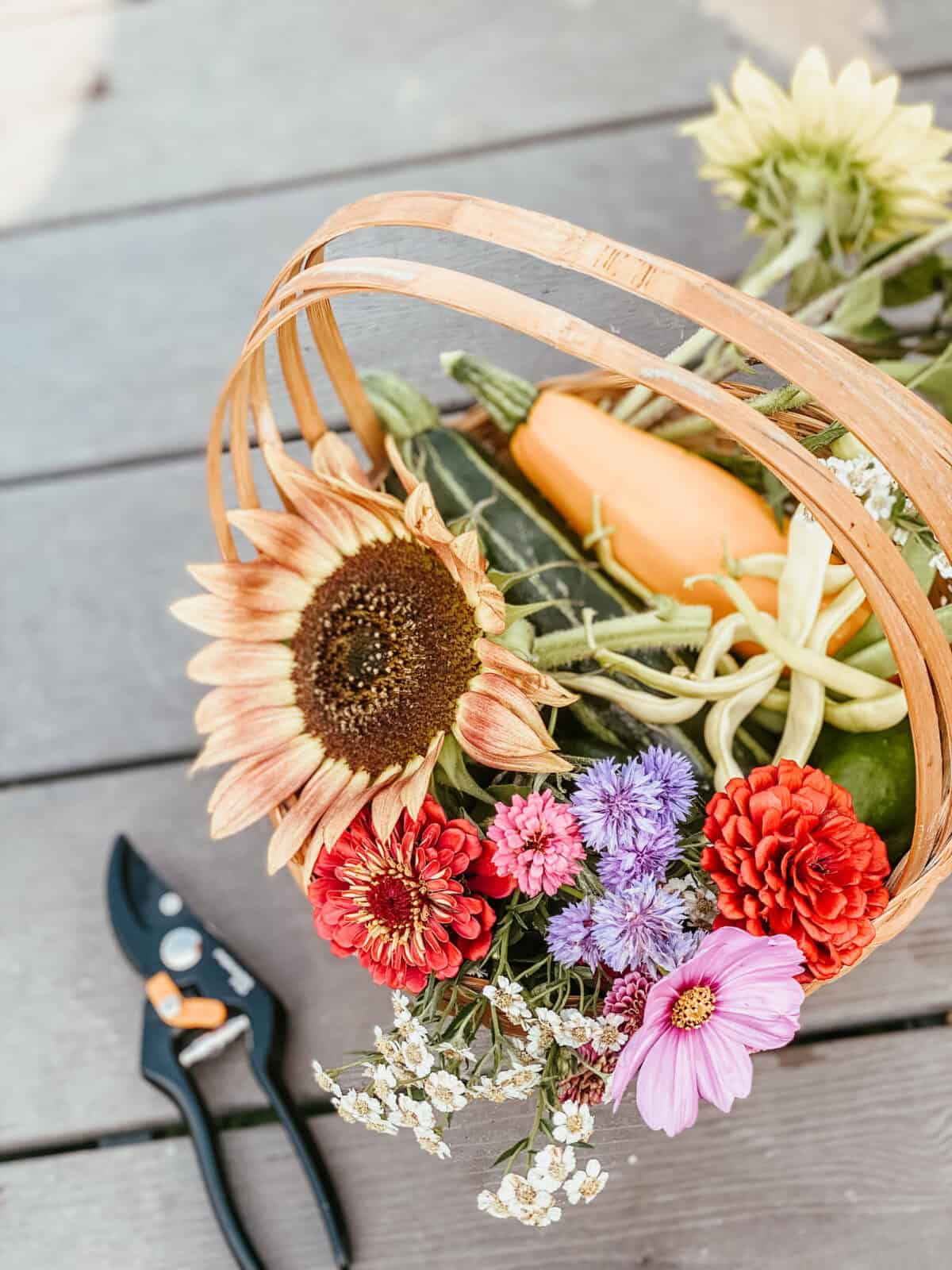
🛠️ Step 1: Choose the Right Spot
Sunlight is key—most vegetables need at least 6–8 hours of full sun each day.
When picking a location, consider:
- Protection from strong winds or curious animals
- Access to water (super important!)
- Drainage (avoid soggy areas)
- How close it is to your kitchen (trust me, you’ll visit it often!)
📏 Step 2: Decide on Bed Size and Materials
Initially when we were setting up our raised bed garden, I went back and forth on design and on creating beds from various materials.
I love the idea of using repurposed materials, but also wanted something that would last long term and was easy to set up. For the majority of our garden now, I use galvanized raised beds. This is mostly because I wanted something that was simple that I could easily put together myself and something super durable for long term.
Other things to consider when building a raised garden bed…
Common beginner size: 4×4 or 4×8 feet.
Keep it no wider than 4 feet so you can reach the center without stepping in the bed.
Material options:
- Untreated cedar or pine (safe and long-lasting)
- Galvanized steel
- Recycled materials like old bricks or logs
🌿 Pro tip: Make sure your materials are non-toxic—you’ll be growing food here!
Related: Easy & Inexpensive Raised Garden Bed Ideas
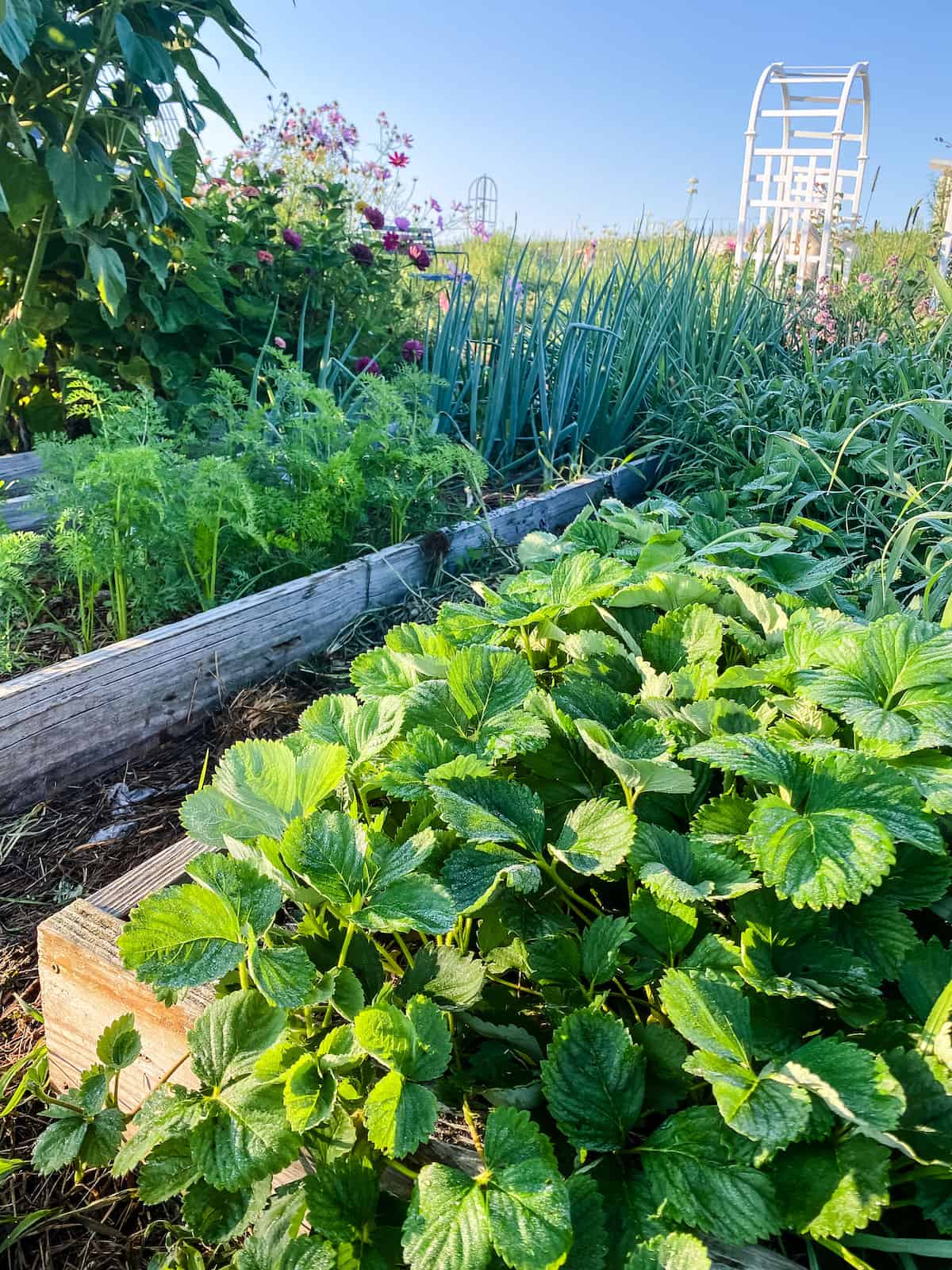
🧱 Step 3: Build or Setup the Beds
You can build your own with simple tools or buy a kit for quicker setup. Once placed, level the bed and clear out any grass or weeds underneath.
Optional: Add hardware cloth at the bottom to deter burrowing critters like moles or gophers.
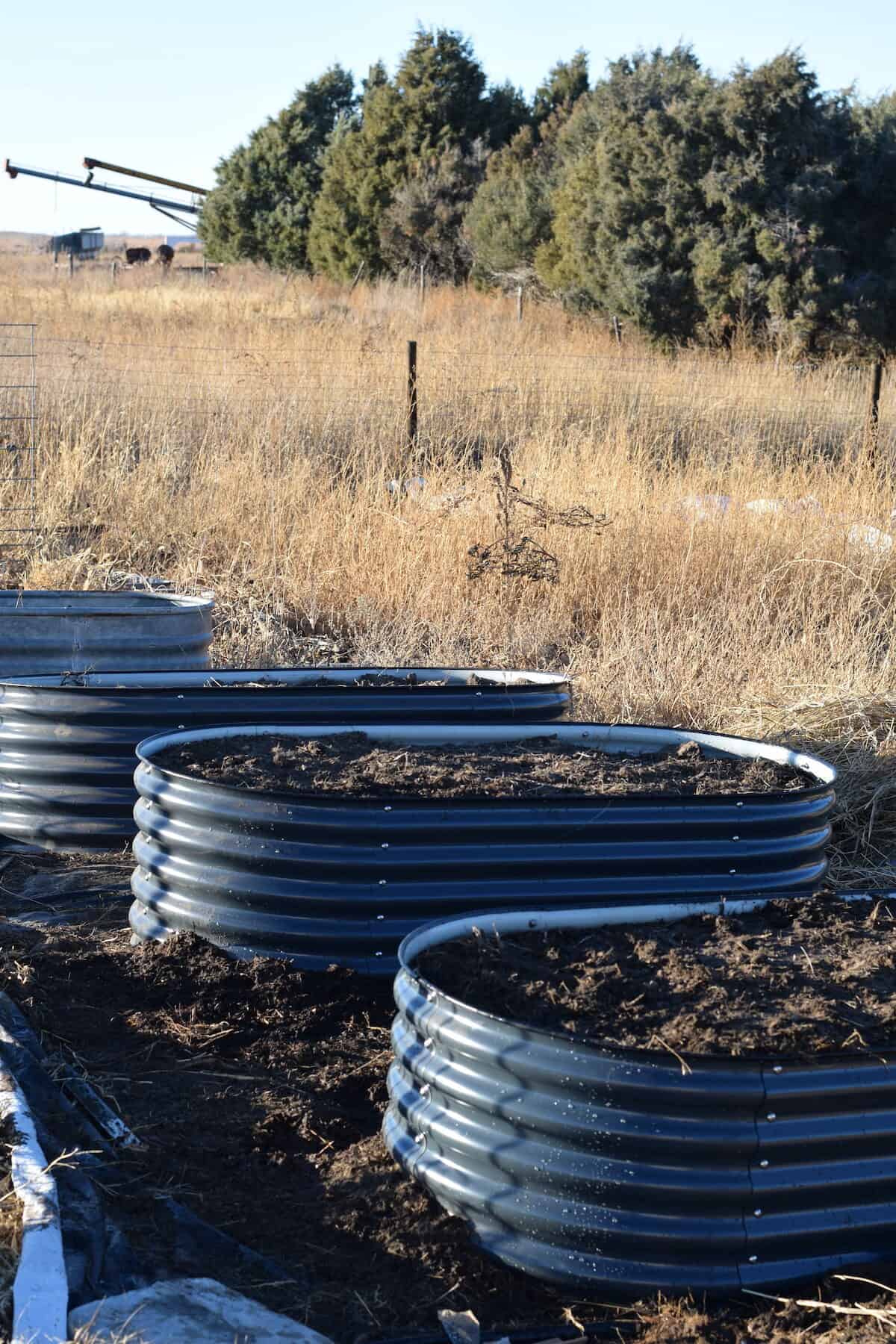
🌱 Step 4: Fill with Healthy Soil
A good soil mix is the secret to a thriving garden. A simple test of the garden soil can help you to determine if you’ll need any amendments.
Here’s a breakdown of how we fill raised beds:
- layer of cardboard, logs, branches & sticks or twigs.
- old rotted hay (kitchen scraps, leaves, grass clippings also works)
- compost – homemade compost is such a great option for keeping costs down and providing beneficial nutrients and organic matter for the garden. If purchasing compost, be sure to choose one of good quality and test it before planting to ensure it’s not too hot.
- Animal manure – this is gold for the garden. I recommend goat manure, if available. Chicken and cow manure is also good. Whichever option you choose, be sure to allow about 4 months of aging/composting before using it in the garden.
- organic topsoil – be sure to choose a high-quality soil for a vegetable garden.
Read more on How to Fill a Raised Garden Bed
🥕 Step 5: Choose Beginner-Friendly Plants
When beginning your first garden be sure to make things easy for success and motivating to continue on the journey.
Choose plants that are:
- Easy to grow
- Fast to harvest
- Family favorites
A few great options include:
- Leafy greens (lettuce, spinach, kale)
- Root veggies (radishes, carrots, beets)
- Tomatoes, zucchini, and bush beans
- Herbs like basil, chives, and parsley
Choose what your family loves to eat and stick with those foods!
🌿 Pro tip: Group plants by their sunlight and watering needs to make care easier.
💧 Step 6: Water & Mulch
Water deeply at the base of the plants in the morning or evening. You would want to try to avoid watering during the heat of the day because the water will likely evaporate and not reach the plant roots.
To retain moisture and reduce weeds, add a layer of organic mulch like straw or shredded leaves. I like to use garden straw because its been the cleanest and easiest to add around the plants.
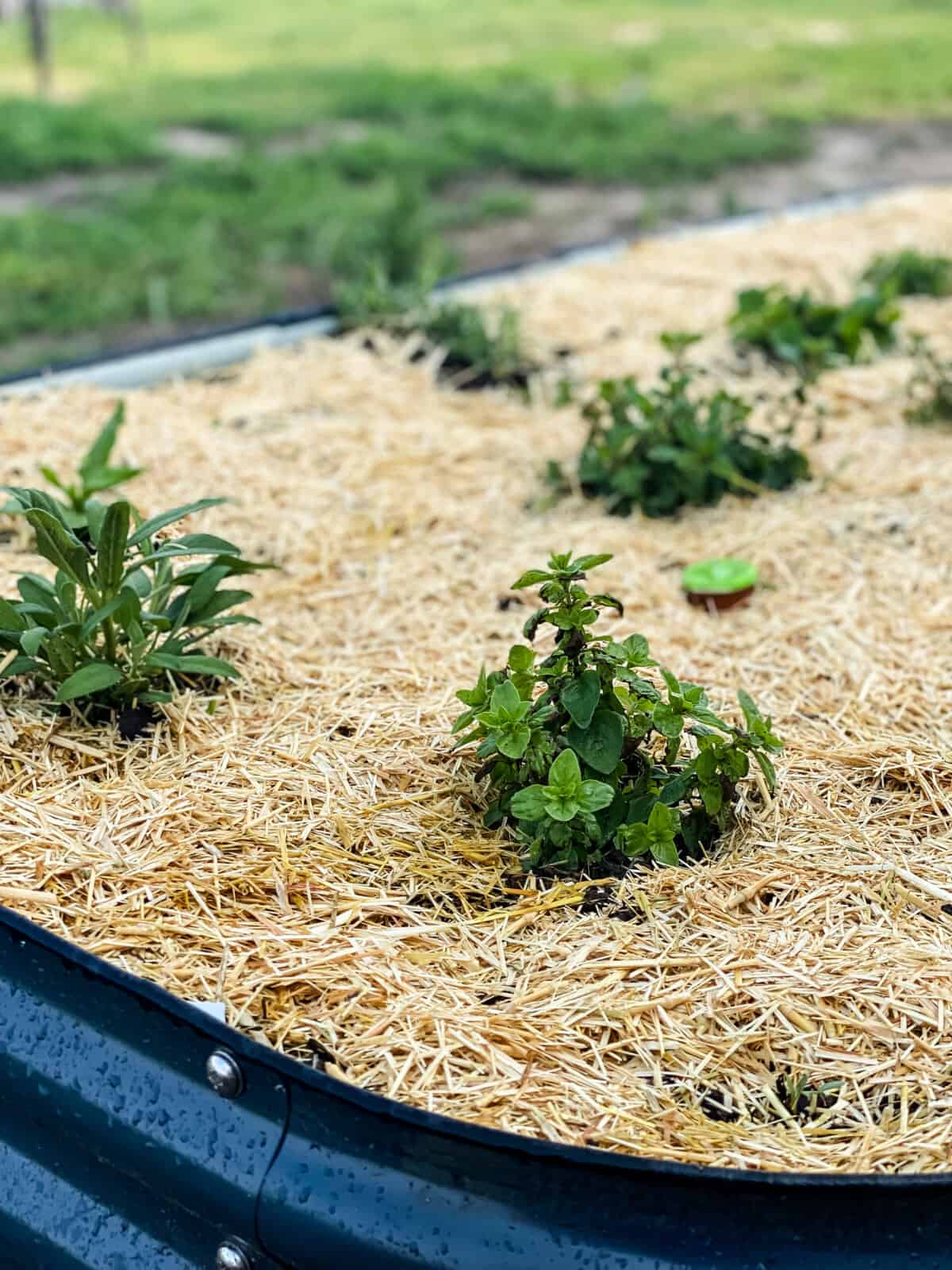
📅 Step 7: Tend Daily (Even Just a Little!)
It’s super important to make time every day to walk the garden paths and check in on how your plants are growing. You’ll also want to spot an issues early so you can tackle them before they become problematic.
Spend 10–15 minutes a day checking in:
- Pull a few weeds
- Harvest what’s ready
- Check for pests
- Say hi to your plants (seriously—it helps you notice issues early!)
As a beginner gardener, you may want to learn about some common gardening mistakes and how to fix them.
🧺 Bonus: Make It a Family Affair
Let the kids help! Raised beds are a perfect height for little hands.
Give them their own section to plant and water—it’s a beautiful way to teach responsibility, patience, and the miracle of growing food.
Early on in the creation of our raised bed gardens, we built each child their own mini raised bed. We used these round beds which come in a pack of 2 – perfect for our 4 children!
Not only do the children love to watch their gardens grow, it gives them ownership and teaches them responsibility of raising their own crops.
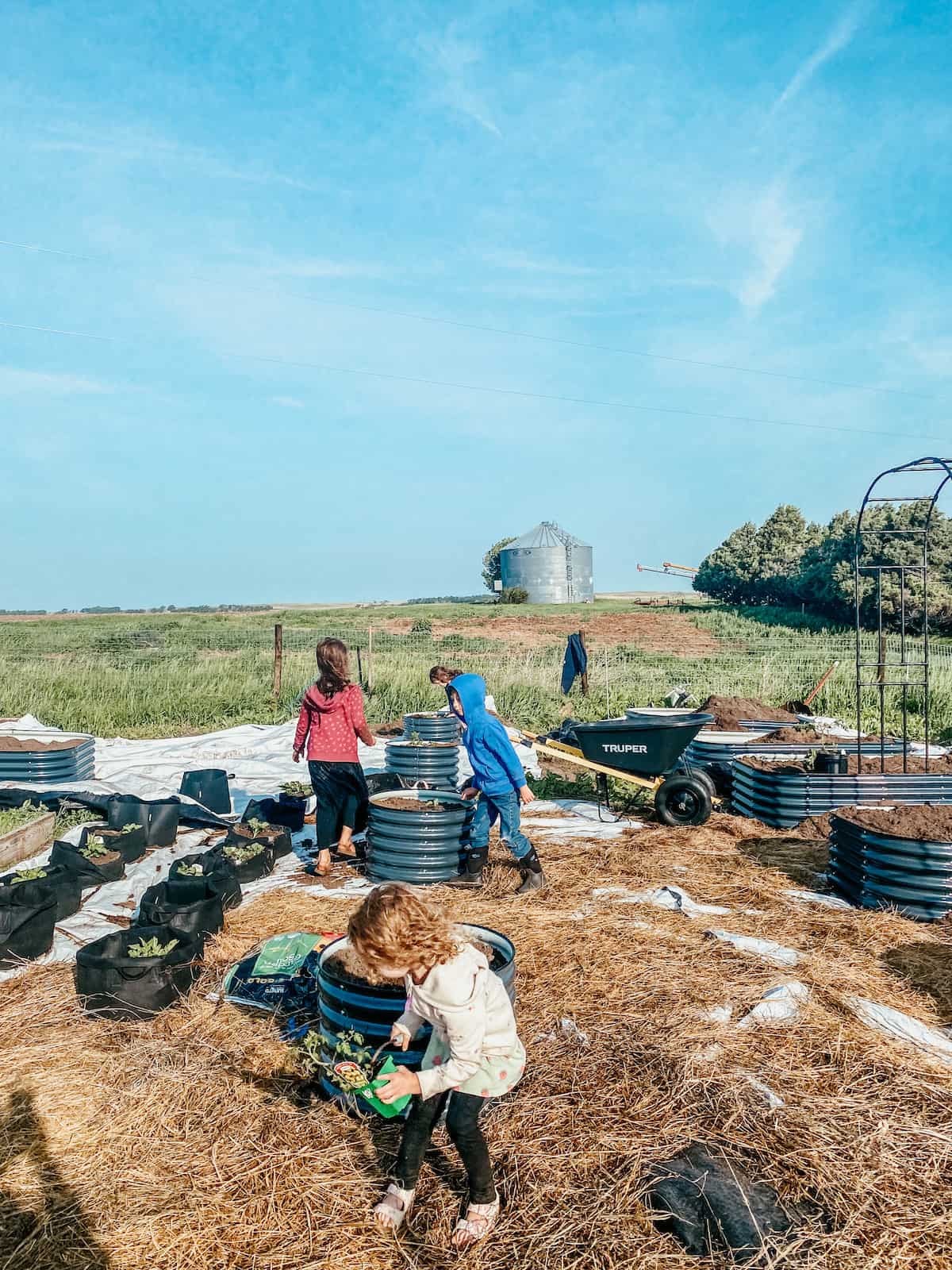
🌻 Final Thoughts
Starting a raised bed garden is one of the simplest ways to live a little more beyond the conventional. You don’t need a big farm or hours each day—just a small patch of good soil, a bit of sun, and a willing heart.
So grab a shovel, friend. Your garden-to-table journey starts today.
🌿 Ready to Dig In?
Download my free Raised Bed Garden Planning Checklist (below) to stay organized and confident all season long!
